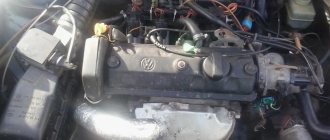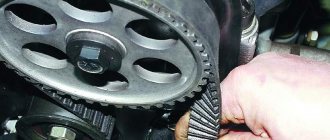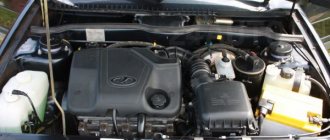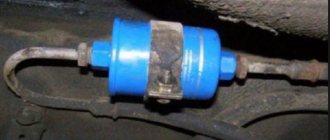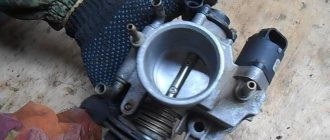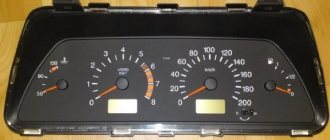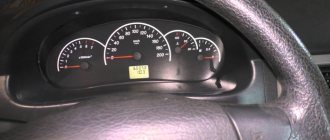This is tough, friends...
How can this be?! It took me 92,000 km, 3 (three!) years and as many as 3 (three!) timing belt replacements to find out that the reason for the constant jerking at idle is trivial! — timing marks
!
I'll start with some background. I bought a wad in 2013 with a defect - when working at XX, it shook and swayed cyclically. In a traffic jam you could feel your head swaying in time with the fawn...
Unfortunately, the video was not saved...
This confused me when I bought it, but it didn’t stop me.
.
So, the wad has been purchased, a normal discount has been requested for the uneven operation of the internal combustion engine, allowing you to immediately order the spare parts and solve the problem once and for all. We didn’t do anything with our fingers, we’ll fix everything now. Yeah. ))
Ordered spark plugs and ignition coil. I changed it - it didn't help.
Yeah, that means pillows. Ordered + replaced = did not help.
Apparently the injectors are clogged. My wynns'om three times did not help.
The diagnostician at work gives me an idea - maybe an air leak? OK, remove the intake manifold and find cracked o-rings on the intake ducts. Due to the lack of new ones, we smear the old ones with sealant, collect them - ZERO result.
Oh yes, I was undergoing diagnostics in a French repair garage (the diagnostician works for an official dealer in his free time from the garage). Verdict - “you need to remove the cylinder head, see what’s there...” (...what the hell is there - valves, pistons, what else). The idea was immediately dismissed as untenable.
By the way, usually when buying a used car, people change all the fluids and the timing belt. But the previous owner gave me a work order to replace the timing belt 15,000 km ago. Therefore, it was planned to get into the timing belt only after 45,000 km, at least.
I tried refueling with 95, 98 - to no avail.
The throttle body was washed, trained in Feng Shui, the pressure sensor in the intake manifold was washed...
A crack was found on the crankcase ventilation tube; it was successfully insulated to no avail.
In the end, I think maybe M E T K I G R M
? ! It’s okay if I change the belt and rollers earlier, but maybe I’ll fix the problem! So, I bought a timing belt kit, read up on how to change it, where the marks are and all that, and went to change it.
I read: “We fix the flywheel with wire. There is a small hole to the right of the oil filter on the block towards the gearbox. Remove the oil filter cover and look with a mirror. We insert a steel wire there, it should go in about 5 centimeters.” And there is even a photo:
Okay, I find a plastic plug behind the oil filter,
I pick it out (I couldn’t put it back, to do this you need to at least remove the oil filter housing...), lock the camshafts with bolts, put the
the hole behind the oil filter (under the plug
), it goes there, with *hey, I got in! I think - fire!
I look, and the mark on my HF looks at 7 o’clock, but it should look at 6!
Hmm... You need to unscrew the camshaft gear and look - maybe the key has been cut off. Fuck it! The KV bolt could not be unscrewed with a pneumatic impact wrench! Well, I think, okay, so I won’t touch the HF gear, otherwise you never know!
I put the belt as it was (the mark on the HF is at 7 o'clock, and the mark on the belt is at 6 :)))), I assemble it - naturally, the engine still rocks.
I have temporarily postponed the solution to this issue, I’m driving like this for now. The wad drives, in principle, normally, confidently. Consumption is around 9 l/100 km, which also suits me quite well. In general, there is no reason to worry. Besides the fact that he still sways, the bastard...
What is a timing belt for?
The timing belt is a rather complex unit in terms of design. It is based on a camshaft located in the cylinder head. With its help, the intake and exhaust valves are pushed. The valves, in turn, ensure the supply of a combustible mixture to the engine cylinders, and also help remove gases from the vehicle system. The operation of the camshaft is possible due to the presence of a crankshaft in the system. Thus, the mechanical force from the second to the first is transmitted using a drive belt.
A malfunction of the camshaft drive will disrupt the gas exchange process in the cylinders. The engine will not be able to function normally, and this is fraught with serious consequences for the main power unit
Didn't notice the valve was bent
If, after a timing belt break, it was replaced, but the engine does not start, then you can suspect a problem with the valves that are bent.
This can be explained by the fact that at such a moment the valve timing is disrupted due to the camshaft stopping. In this case, the valves stop functioning, and the pistons hit them with all their might. As a result, the valves become bent, even damaging the pistons. This leads to expensive engine repairs.
In such situations, it is impossible to solve the problem by replacement alone. To eliminate possible bends, remove the valve cover and rotate the shaft by hand. If one of the valves does not work, then it is bent. On the other hand, with slight bending, the power unit will work. For more accurate diagnostics, you need to remove the cylinder head.
Why and when you need to change the timing belt
As is clear, the timing base is the camshaft, which is located in the cylinder head and pushes the intake/exhaust valves. The camshaft is driven from the crankshaft by a drive belt. Timely opening and closing of valves must be carried out in a strictly established order and in accordance with the engine operating cycles.
In other words, during the intake stroke the intake valve must open, so air or a fuel-air mixture (depending on the type of engine) enters the cylinders. Next, the consistency is compressed (the piston moves to TDC), at this moment all valves are closed. After the fuel charge is ignited and useful energy is released to the piston, the exhaust valve opens to remove exhaust gases from the engine cylinder. This is how the gas distribution process is carried out.
We recommend: Replacing antifreeze Lada 2110 (VAZ 2110)
You should also take into account a number of reasons that can significantly reduce the service life of any belt. For example, engine oil getting on the timing belt as a result of leaks in the crankshaft front oil seal can quickly render the designated camshaft drive element unusable. Problems with the tension roller, jamming of the pump and other malfunctions are the reasons why the belt breaks or wears out quickly.
If signs of wear on the timing belt are noticeable or the time for its scheduled replacement is approaching, then it is not much to simply install a new element. When replacing, the belt should be set correctly. To replace and expose, you need to prepare tools; it is also better to service the car on a lift or in a garage with an inspection pit. The smallest set for this operation can be considered a jack, screwdrivers, spanners and socket wrenches, a socket wrench, preferably a wrench with a socket head, etc.
The car does not start after replacing the timing belt, timing chain or carrying out other work on the gas distribution mechanism drive. Main prerequisites, advice.
When is it necessary to replace the timing belt and set the marks?
Without exaggeration, a worn timing belt can be called a “ticking time bomb.” The importance of this element in the car system is difficult to overestimate. Usually it is made of high-quality rubber, the service life of which is designed for 50-60 thousand kilometers. But, if the vehicle is operated in unfavorable conditions, the replacement interval will be different.
Replacing a belt and pump is a labor- and financially expensive process. But all the work will cost much less than repairing a failed engine due to a broken gear mechanism. In no case should you save money and put off scheduled car maintenance “for later.”
In most cases, the replacement interval is indicated by the manufacturer in the documentation for the vehicle. In addition to the resource built into the belt, it is worth considering the following factors that shorten the service life of the rubber element:
As you can see, there can be a sufficient number of breakdowns in the car system that directly affect the service life of the belt. If the scheduled replacement time has come, or its resource has been prematurely exhausted, it is not enough to simply replace the old mechanism with a new one - you also need to take care of the correct installation. To successfully do all the work, it is enough to arm yourself with the necessary tools and know how to align the belt with the marks.
Repair cost
The average price for replacing a belt and roller in car services ranges from one to three thousand rubles. The price range is due to the fact that replacing parts on foreign cars costs approximately 2–3 times more than on domestic cars.
If it turns out that you also need to change the engine water cooling pump and the crankshaft oil seal, then the price will increase by another 1 - 1.5 thousand rubles.
Although there is a huge selection of products on the market at different price levels, you should only choose brands recommended by the manufacturer or their high-quality analogues. Using cheap parts can lead to serious damage and expensive repairs.
For example, if the valves are bent as a result of a belt slipping, then almost the entire cylinder head will have to be replaced. Even if the repair is carried out by yourself, the cost of replacing valves, pump, belt, filling oil and antifreeze, and other parts will be at least 10,000 rubles.
signs symptoms and repair methods
Like any other car component or part, the timing belt performs certain functions. It is entrusted with a significant option, and due to the convincingness of its functioning, the operational duration and security of the automotive power plant as a whole is determined.
Can the timing belt jump?
Author's note: Jumping or slipping of the timing belt is a fairly common phenomenon familiar to many motorists. The belt slips one tooth or several. We are talking about the teeth of the crankshaft or camshaft flywheel. It is clear that such a situation can lead to serious problems.
The main reasons why the timing belt jumps
This is how a timing belt works
The timing belt is an important element of the car, so it needs to be serviced promptly. The reasons that lead to its jump are the following:
Of course, these are not all cases due to which the timing belt breaks or jumps. But this can be understood by the following signs.
What to do if the timing belt on a Priora has jumped - video
Signs and Symptoms of a Timing Belt Jumping
In internal combustion engines that use a timing belt in the timing drive, there is always the danger of it jumping over one or more teeth.
If the timing belt has jumped, the signs of this, depending on the design of the engine, may be the following:
Author's Notes: As a rule, if the timing belt jumps within two teeth, the engine will continue to run, but with visible interruptions. When the belt jumps more than two teeth, the consequences can be very different.
Using front-wheel drive vases as an example, the following happens:
A similar malfunction, such as a timing belt that has jumped, is usually caused by either an oil leak that has reached the belt teeth, an antifreeze leak, a faulty tension roller, or extreme belt wear.
What to do if your timing belt has jumped one or more teeth
As a rule, a timing belt jump does not immediately lead to extreme problems, but the engine begins to function intermittently or does not start. The explanation is simple: the gas protection phases are incorrect, the general cycle of fuel supply and cylinder cleaning is disrupted.
Timing belt assembly with rollers
The reason for timing belt jumping is often due to the fact that a little oil or coolant drips onto the rubber material of the timing element. The pump is leaking, the cuff of any shaft is malfunctioning - in a word, anything related to oil or liquids can lead to this. Therefore, if you find a malfunction, you must do the following:
At the final stage of work, check the identity of the marks again. For example, while the crankshaft flywheel is removed, you can additionally diagnose the mark on the crankshaft by comparing the mark on the shaft sprocket and the cutout on the oil pump boss. If the marks are not in place, you will have to repeat the installation again. This is done until the marks match. After this, the crankshaft is turned two turns, and compatibility is re-diagnosed. If the marks match, you need to proceed to assembly.
After everything is assembled, the power unit starts. If a characteristic hum appears, which should not be there, this clearly indicates that the belt is overtightened. You will have to re-adjust.
Correctly marking the timing belt
After closing the belt with the protective cover, it is recommended to check the belt for snagging, and the power unit for clean operation. If knocking and noise does not disappear, it is recommended to install the cover with bolts, thereby tightening it into the desired position.
Video: How to find out if your engine valves bend when the timing belt breaks
Signs and symptoms
There are six main signs that the timing belt has jumped.
- The car engine is unstable.
- The engine constantly stalls.
- Noticeable loss of engine power and thrust.
- The engine starts with problems or does not start at all.
- The power plant is stuck.
- The sound of the engine becomes louder - a metallic knock appears.
Most often, it happens that the product jumps one tooth, and because of this, the engine continues to operate, but increases fuel consumption, and there are also interruptions in operation and starting.
If you suspect that several teeth have jumped, you should not restart the engine. In the worst case, this can cause the valves to bend.
We set the timing belt ourselves
The process of setting tags yourself is not that complicated, but it does require some in-depth knowledge. Among other things, it is periodically necessary to check the position of the shafts, since they tend to change their location relative to other timing elements for various reasons. In the following two situations, you have to set marks almost every time:
It should also be taken into account that on cars with a sports camshaft, the principle of setting the drive belt may be completely different. To know exactly how to do all the work on sports or tuned cars, it is best to familiarize yourself with the detailed information provided in the instructions for a specific power unit.
Having all the necessary tools in hand, you can proceed directly to the main work. All work comes down to the following steps:
Then, in reverse order, we collect everything that was originally removed. This method is suitable if the timing belt is fully tensioned. If the marks do not match, you will have to remove the belt and place marks separately on the crankshaft and camshaft.
Mismatch with flywheel mark
For many car models, a special mark is applied to the surface of the flywheel, which must coincide with the position of the belt. The flywheel is usually dirty, so identifying such a mark is not so easy. In addition, there are special pits on the surface of the flywheel that can be easily confused with a scratch mark.
If you mistakenly focus on these recesses when installing the timing belt, the engine may not start at all. You can use the crankshaft position sensor as a beacon when searching for a mark.
What happens if the timing belt jumps one tooth?
Timing belt jumped - DRIVE2
The timing belt performs an important mission in a car, and the durability and safety of the engine depends on the reliability of its operation.
On some engine models, a belt break or slippage when the timing belt has jumped several teeth on the crankshaft or camshaft pulley can lead to serious damage.
If, even when the timing belt jumps, no emergency occurs, the engine begins to operate intermittently or stalls altogether.
This is due to the fact that the valve timing is disrupted and the cycle of fuel supply and cylinder purging is disrupted. Typically, such cases occur when oil or antifreeze gets on the timing belt. This could be a leaking pump or a broken seal on one of the shafts. On front-wheel drive VAZ 2108-09 cars and their modifications, sometimes the cause of oil getting into the timing belt operating area is a leaking oil pressure sensor located at the top left of the belt cover.
Therefore, the condition of the belt must be given increased attention, namely; Do not leave a fresh suspicious spot in the area of the belt cover for later. Sometimes there may be no “later”, since even a small amount of oil can create conditions for the timing belt to jump.
If no visible traces of oil or antifreeze are observed, but the engine nevertheless behaves in an unusual way, i.e. does not develop speed, starts poorly or stalls frequently - remove the timing belt cover and make sure the marks are installed correctly.
When replacing the timing belt, always ensure that it is installed accurately, even on one tooth of the belt; the mark will definitely negatively affect the operation of the engine, and on some models, starting it will become impossible, since the valve timing will be disrupted. This especially applies to diesel engines, which react very sensitively to inaccurate belt installation.
Having aligned the engine to the factory marks, start installing the belt from the long, free side, immediately giving it a preload, and only then lay it further through the rollers. The teeth of the timing belt must fit exactly into the recesses of the pulleys, but if this is not possible, then move the crankshaft or camshaft slightly so that the belt tooth fits neatly into the recess on the pulley. After installation, check the alignment of the marks again by turning the crankshaft two turns.
The timing belt jumped onto a tooth of a VAZ car: signs, symptoms and repair methods
Like any other car component or part, the timing belt performs certain functions. It is entrusted with a significant option, and due to the convincingness of its functioning, the operational duration and security of the automotive power plant as a whole is determined.
Can the timing belt jump?
Author's note: Jumping or slipping of the timing belt is a fairly common phenomenon familiar to many motorists. The belt slips one tooth or several. We are talking about the teeth of the crankshaft or camshaft flywheel. It is clear that such a situation can lead to serious problems.
The main reasons why the timing belt jumps
This is how a timing belt works
The timing belt is an important element of the car, so it needs to be serviced promptly. The reasons that lead to its jump are the following:
Of course, these are not all cases due to which the timing belt breaks or jumps. But this can be understood by the following signs.
What to do if the timing belt on a Priora has jumped - video
Signs and Symptoms of a Timing Belt Jumping
In internal combustion engines that use a timing belt in the timing drive, there is always the danger of it jumping over one or more teeth.
If the timing belt has jumped, the signs of this, depending on the design of the engine, may be the following:
Author's Notes: As a rule, if the timing belt jumps within two teeth, the engine will continue to run, but with visible interruptions. When the belt jumps more than two teeth, the consequences can be very different.
Using front-wheel drive vases as an example, the following happens:
A similar malfunction, such as a timing belt that has jumped, is usually caused by either an oil leak that has reached the belt teeth, an antifreeze leak, a faulty tension roller, or extreme belt wear.
What to do if your timing belt has jumped one or more teeth
As a rule, a timing belt jump does not immediately lead to extreme problems, but the engine begins to function intermittently or does not start. The explanation is simple: the gas protection phases are incorrect, the general cycle of fuel supply and cylinder cleaning is disrupted.
Timing belt assembly with rollers
The reason for timing belt jumping is often due to the fact that a little oil or coolant drips onto the rubber material of the timing element. The pump is leaking, the cuff of any shaft is malfunctioning - in a word, anything related to oil or liquids can lead to this. Therefore, if you find a malfunction, you must do the following:
At the final stage of work, check the identity of the marks again. For example, while the crankshaft flywheel is removed, you can additionally diagnose the mark on the crankshaft by comparing the mark on the shaft sprocket and the cutout on the oil pump boss. If the marks are not in place, you will have to repeat the installation again. This is done until the marks match. After this, the crankshaft is turned two turns, and compatibility is re-diagnosed. If the marks match, you need to proceed to assembly.
After everything is assembled, the power unit starts. If a characteristic hum appears, which should not be there, this clearly indicates that the belt is overtightened. You will have to re-adjust.
Correctly marking the timing belt
After closing the belt with the protective cover, it is recommended to check the belt for snagging, and the power unit for clean operation. If knocking and noise does not disappear, it is recommended to install the cover with bolts, thereby tightening it into the desired position.
Video: How to find out if your engine valves bend when the timing belt breaks
Support the site - Share the article on social networks:
P0340 or the timing belt does not hit 1 tooth - logbook Hyundai Getz 1.6 16V 2004 on DRIVE2
The receipt from the purchase was on fire. The owner threw up his hands, saying he blinked when it caught fire, but the car was running, so there was no need to get into it. I immediately thought it was error 340 - an error in the camshaft sensor circuit. The Internet said that it was the Khan sensor, that oil could get into its contact and that’s all, provided that the car was driving. I accidentally came across on some website about other cars in general that the same error was on, but as it turned out, the timing belt did not hit 1 tooth according to the marks. The car is moving, but the gas timing is already off. In contact with the Goetz group, the guru immediately said that if the timing belt is knocked off by 1 tooth, then the valves will knock. In the group of accent guides (their motor), essentially no one answered anything. And the other day, one comrade in the accent group made a note that error 342 was on, he opened the covers, and there on the camshaft pulley the mark did not match by 1 tooth, he set everything again, the error went out and the car froze. Well, I read a lot of manuals (most smart), bought a 22 head and went to the garage with jitters and trembling in my knees) I’ll say right away that there’s nothing complicated, just very scary.
I opened the lid - this is what happened
I reinstalled everything again, 100,500 crankshaft revolutions to check the marks - everything was fine, assembled, started - UUURRRAAA - the check went out! I've already driven 8 kilometers, and managed to get used to the car. BUT after the first start: the engine is quieter, the idle speed is lower, the auto pickup table is much smoother! The jitters remain! But you never know what will tear, unscrew, etc. brr))
If the timing belt has jumped or broken | Motorist's benefit
The timing belt on a car engine ensures synchronization of the crankshaft with the timing shaft (camshaft). On engines with a timing belt, breaking it or slipping even one tooth can lead to serious problems, which in the future may lead to a major overhaul of the engine.
Signs of a timing belt that has jumped on the pulley
If the timing belt has jumped, the symptoms may be as follows:
- Unstable motor operation
There may be several reasons why the timing belt may jump. Firstly, low tension, and secondly, the presence of oil on the camshaft or crankshaft pulley can cause the belt to slip. Well, and most importantly, a broken timing belt can ultimately lead to damage to the valves of the gas distribution mechanism and internal elements of the internal combustion engine (pistons, connecting rods, etc.)
Broken timing belt while driving
Causes of timing belt breakage
Why does the timing belt break? There may be several reasons for this, and one of the main ones is its wear and tear. Therefore, the manufacturer strongly recommends replacing the timing belt within the vehicle mileage interval specified by the regulations. Next, it is worth noting that the tension roller is damaged or weakened, which can undoubtedly cause the belt to break or slip. The cause of the break may also be a jammed water pump pulley. If the engine has two camshafts, then the failure of one can also be a consequence of a broken timing belt, but in this case the consequences can be completely different, more disappointing.
Consequences of a broken timing belt on a Lada Priora engine
How to avoid timing belt breakage or slippage
First of all, it is necessary to strictly observe the timing belt replacement interval, in most cases this is 60,000 km. vehicle mileage. Next, keep an eye on the oil seals, including the crankshaft; oil drips under the hood are a sign of one of them leaking. Periodically check the tension of the timing belt; if it becomes loose, immediately take measures to tighten it. Always use original spare parts when replacing a belt. This also includes replacing the pump; buy only the one recommended by the manufacturer.
Find out in more detail when it is necessary to change the timing belt on an internal combustion engine
Photo reports on replacing the timing belt
Opel Astra Renault Logan Audi A4 Audi 100 Chevrolet Lacetti Chevrolet Aveo On diesel engines Volkswagen Toyota Estima Emina 3C Renault 25 Mazda Demio
Related publications:
The main nuances of the functioning of the timing belt in cars
It is extremely important to understand that the rubber timing element is responsible for transmitting the timing gear in the motor shafts. The latter, in turn, are responsible for the maintenance of the air-fuel mixture in the cylinders of the power unit.
If the timing belt jumps or breaks, the entire timing belt system begins to function differently. All this is manifested by shifts and malfunctions of the most important component of the car - its engine. It was written in detail above that in these cases the power of the power plant necessarily decreases, fuel consumption increases and starting deteriorates.
In addition, slippage or rupture of the timing component can cause failure of the piston-valve group in the engine. When the belt breaks, the valves open towards the piston, which leads to internal engine problems.
Monitoring the condition of the timing belt is a guarantee of preventing severe consequences for the power plant. But it is important to be able to control not only the appearance of the belt, but also the degree of tension. On their own, which is quite natural, it will be extremely difficult for a person with non-professional skills to diagnose the correct installation of the belt. In order not to make a mistake, you need to pay attention to the service life of the belt and the condition of the parts accompanying the operation of the element. In particular, ensuring the degree of tension and uninterrupted operation.
The period for replacing the most important timing part may vary. It depends on the specific car manufacturer. In addition, it is necessary to take into account such an indicator as the originality of the part. It is clear that “left” companies can easily produce defective belts or belts with a reduced service life.
It is also important to understand that on the modern market you quite often find parts of the universal type rather than the standard one. What does it mean? It's simple - universal parts, belts in this case, are not made for a specific car. They are not a priori characterized by good quality, and although they are cheaper than the original ones, they are not recommended for purchase.
You can distinguish an original belt from a universal one (there are several effective ways). If the part is universal, then to determine the service life of the belt and its replacement, you will have to take this into account. In other words, if the manufacturer indicated that the belt can last 70 thousand kilometers on his car, this does not apply to the universal one. This one will definitely last less.
As mentioned above, the service life of the belt on front-wheel drive VAZs is approximately 60-70 thousand kilometers. If the car was purchased secondhand, you should not trust its owner who claims that the belt is new, there will be no problems with it.
When choosing a new timing belt for your car, it is recommended to pay great attention to the material. If there are no marks left on the rubber after several folds in and out, most likely the material is fine.
But on the contrary, if even the slightest microcracks are noticed, it is better not to buy such a belt right away.
It is also recommended to check the belt model number with the number specified in the operating manual for a specific vehicle. The numbers are unlikely to match; it is a great success if such a belt can be found. But you can check belts in another way: by comparing the length, width and thickness of the old factory belt and the new analogue.
The belt must also be checked around its entire circumference. If protruding threads are noticeable on the ribs, the cord will be visible, it is better to immediately abandon this option.
If you do not have the appropriate skills and ability to work with your own hands, it is better to entrust replacing the timing belt to professionals. Without a doubt, a seemingly simple operation at first glance can fray your nerves and take a lot of effort. And most importantly, an illiterate replacement can lead to even bigger problems.
Note. The main difficulty in replacing a belt is setting the marks.
Of course, in a big city it will be easier to find a quality car service among the many options. In rural areas, you have to rely on the honesty of service station workers or carry out this event yourself. The most important thing is that it does not matter which method was chosen, what is more important is to save time and money, getting the highest quality result.
Forget about fines from cameras! An absolutely legal new product - Traffic Police Camera Jammer, hides your license plates from the cameras that are installed in all cities. More details at the link.
- Absolutely legal (Article 12.2);
- Hides from photo and video recording;
- Suitable for all cars;
- Works through the cigarette lighter connector;
- Does not cause interference to radios and cell phones.
Do-it-yourself timing belt alignment
A timing belt is a relatively common solution for driving timing gear and other equipment compared to a timing chain. With all this, the designated belt serves less than the chain, in other words, it needs repeated replacement. Most drivers know that when replacing the timing belt, the drive pulleys are marked according to marks, which is necessary for precise synchronization of the operation of the engine and the gas distribution mechanism.
With all this, not many people fully understand how to correctly set the timing belt when replacing it themselves and why this is so important. Let us immediately note that if the timing belt is not aligned with the marks, then a failure of the valve timing occurs. As a result, the engine may not start after such a replacement, it will work unstably, or even the internal combustion engine may break down. In this article we will talk about what are the symptoms of an incorrectly aligned timing belt, as well as how to align the timing belt with or without marks.
Read in this article
Phased mitigation
Setting up tags
To avoid such situations when the car does not pull after replacing the timing belt, it is necessary to immediately correctly align the crankshaft and timing pulleys according to the marks.
Let's consider the process using the example of a domestic VAZ car with a 16-valve engine.
The marks on the pulleys are aligned
2. Set the flywheel mark
3. Marks on the crankshaft and oil pump
We recommend: Symptoms of a faulty oxygen sensor
Setting the ignition
1. Set the marks first
2. While turning the distributor, catch the spark
We clean the injectors with our own hands
1. Connect the nipples to the bottle
2. Connect the filter to the hose
3. Install the system and flush the nozzles
Consequences
The consequences of the timing belt jumping several teeth can be different - from replacing the timing belt itself to repairing the car’s gas distribution mechanism.
The amount of damage depends on whether the engine has recesses for valves in the pistons or not.
A jump can occur while the valves are being lowered to inject fuel or release gases. The pistons are still moving and can hit the valves hard. This will lead to bending of the latter. This situation is similar to a broken timing belt. You can read more about which engines this happens on in this article.
To avoid this situation, it is recommended to do a timely inspection and, if necessary, change the consumable.
How to tension the timing belt?
If tensioning of the rubber element is required, then simply insert a special key or screwdriver into the tension roller. If in the longest section the key turns 90 degrees, then the tension is normal. The inability of the key to turn will indicate that the tension is too strong, which means it needs to be loosened a little. The nut in the tension roller is loosened, after which the tension level is checked again. Evidence of a low tension level will be the ability to turn the key idle.
What happens if you set the tags incorrectly?
The consequences of a job done incorrectly can range from minor to significant. It is for this reason that it is important to approach all work responsibly. If you don’t have the proper attitude or self-confidence, entrust the work to a professional auto mechanic. Depending on the brand of the car, the following troubles may arise during the operation of the car:
The above consequences of incorrect label installation are observed in most cases. But, for example, on an 8-valve VAZ-2114 engine, the valves do not bend or bend even in the most severe cases. But the 16-valve power unit of the “fourteenth” does not have such advantages, so a major overhaul of the engine may be required.
Source
Old videos
As the vehicle is used, all elements of the gas distribution mechanism wear out. If the belt is worn out and loses its functionality, then the tension roller will deteriorate in quality even when it looks quite good on the outside.
It is not recommended to skimp on this important part, since excessive load on it when tensioning a new belt can lead to jamming and another break.
In addition, the new timing belt on the old pulley may slip. This phenomenon will inevitably lead to increased wear of all elements. In addition, the power unit will be noisier. So it’s better to change the entire set.

